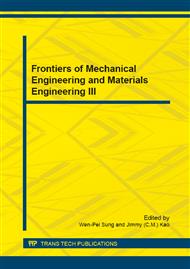p.99
p.103
p.107
p.111
p.115
p.119
p.123
p.126
p.130
Research on the Material Differences of 7050-T7451 Aluminum Alloy
Abstract:
Microstructure analysis and tensile fracture analysis were conducted on the domestic and imported 7050-T7451 aluminum alloy to investigate the material differences between them. Tensile test shows that the yield strength and tensile strength of domestic 7050-T7451 aluminum alloy are both higher than imported 7050-T7451 aluminum alloy, however, the material elongation and the reduction of area are both lower than imported material. Microstructure analysis shows that compared with domestic 7050-T7451 aluminum alloy, in the imported 7050-T7451 aluminum alloy, the degree of recrystallization and anisotropy is less, and the grain size is smaller. In addition, the transition from material surface to center organization of imported 7050-T7451 aluminum alloy is more smooth and uniform than domestic material. From tensile fracture analysis, it concluded that the domestic 7050-T7451 aluminum alloy has large grain size, low structural homogeneity, and little toughness characteristic of fracture, and those characteristics cause low elongation and low reduction of area of domestic 7050-T7451 aluminum alloy.
Info:
Periodical:
Pages:
115-118
Citation:
Online since:
January 2015
Authors:
Price:
Сopyright:
© 2015 Trans Tech Publications Ltd. All Rights Reserved
Share:
Citation:


